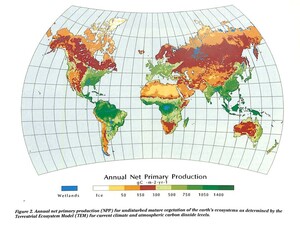By 1985, scientists who studied ecosystems were very interested in process studies as a way to understand what controls the flow of nutrients in a system. In the late 1980s and early 1990s, Ecosystems Center researchers developed two models that were process-based, also called mechanistic models. Process-based models rely on ecological principles to predict future states of a specific system. Ecosystems Center scientists were particularly interested in creating process-based models to predict the impact of two changes on terrestrial ecosystems: rising concentrations of carbon dioxide and increased temperature.
In 1991 Ecosystems Center researchers developed a process-based model called the Terrestrial Ecosystem Model (TEM). Jerry Melillo, David McGuire, and David Kicklighter from the Ecosystems Center collaborated with Berrien Moore, Charles Vörösmarty, and Annette Schloss from the University of New Hampshire to develop this model. TEM predicted how increases in temperature and carbon dioxide concentrations would impact the amount of carbon captured by plants at a regional and global level. Using data on soil, vegetation, temperature, and climate for more than 56,000 patches of land, TEM generated new data on the flows of nitrogen and carbon in land ecosystems. The Terrestrial Ecosystem Model helped scientists to predict the impacts of an increase in carbon dioxide levels, temperature, and both, on different types of ecosystems, from arid deserts to rainforests.
Another process-based model published in 1991, called the General Ecosystem Model, predicted the long-term (up to 100 year) impacts of increased carbon dioxide and temperature on deciduous forest and tundra ecosystems. Ed Rastetter, who started as a post-doctoral fellow in 1986 and later became part of the scientific staff of the Ecosystems Center, led this project, and researchers Gus Shaver, Jerry Melillo, and Robert McKane contributed. Unlike TEM, the General Ecosystem Model used human-defined parameters, instead of data, to simulate carbon storage in land ecosystems. It specifically took into account the carbon and nitrogen ratios in plants and soils, which limit how ecosystems react to change. Center researchers calibrated the model to apply to the Long Term Ecological Research projects in Alaska and Massachusetts. The General Ecosystem Model predicted that terrestrial carbon stocks are “strongly influenced” by the amount of nitrogen present in plants and in the soil.
Stable Isotope Research
- Peterson et al. 1985
- Peterson and Frye, 1987
- http://www.uwyo.edu/sif/stable-isotopes/index.html
Computers and the Internet
- LTER Report: Internet and LTERs 1990
- LTER Report: Tech development LTERs 1991
- NSF Report http://www.nsfnet-legacy.org/about.php
Microbiology and Molecular Biology
- Hobbie et al. 1977
Historical Contet of Climate Change Research
- Canadell et al. 1999
Global Carbon Cycle Project
- Houton et al. 1983
- Moore et al. 1981
- Rastetter and Shaver 1992
Processed-based Models TEM and GEM
- Melillo et al. 1993
- Raich et al. 1991
- Rastetter et al. 1991
Long-term Ecological Research at the EC Historical Context
- Hagan 1992, An Entangled Bank
- Hobbie et al., 2006
Arctic Long Term Ecological Research: Toolik Lake, Alaska
- Chris Neill. https://www.youtube.com/watch?feature=player_embed...
- Hobbie and Kling, Eds, 2014, Alaska's Changing Arctic: Ecological Consequences for Tundra, Streams, and Lakes
- 1987 LTER NSF proposal
- 1998 LTER NSF proposal
- 2010 LTER NSF prososal
- http://arc-lter.ecosystems.mbl.edu/
Forest Long Term Ecological Research: Harvard Forest, Massachusetts
- http://science.energy.gov/ber/highlights/2013/ber-...
- Frey et al. 2013
- LTER 1 grant, 1988 http://harvardforest.fas.harvard.edu/sites/harvard...
- Melillo et al. 2002
Coastal Long Term Ecological Research: Plum Island Sound, Massachusetts
- Hayden et al. 1996 http://atlantic.evsc.virginia.edu/~bph/LTER_LMER/w...
- NSF LTER proposal 1998
- NSF LTER proposal 2002
- Valiela, 1995. Marine Ecological Processes.
- VIMS, Nutrient cycling: http://web.vims.edu/bio/shallowwater/ecosystem_pro...
Ocean Flux Program
- MBL. ND. "Ocean Flux Program." Ecosystems Center a the MBL. http://www.mbl.edu/ecosystems/conte/ofp/
- Chapin III, Stuart F., Pamela A. Matson, Peter M. Vitousek. 2012. Principles of Terrestrial Ecosystem Ecology. Springer: New York.
- Conte, Maureen. 2014. "Particle Flux in the Deep Sargasso Sea The 35-Year Oceanic Flux Program Time Series." The Official Magazine of the Oceanography Society Oceanorgraphy. 27(1). http://tos.org/oceanography/assets/docs/27-1_conte...
Semester in Environmental Science Program
- The Ecosystems Center Report 2015-2016
- MBL. ND. "Student Projects." Ecosystems Center a the MBL. http://www.mbl.edu/ses/courses/projects/
- MBL. ND. "Semester in Enviromental Science." Ecosystems Center a the MBL. http://www.mbl.edu/ses/

